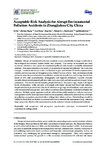Acceptable Risk Analysis for Abrupt Environmental Pollution Accidents in Zhangjiakou City, China
| dc.contributor.author | Du, X | |
| dc.contributor.author | Zhang, Z | |
| dc.contributor.author | Dong, L | |
| dc.contributor.author | Liu, J | |
| dc.contributor.author | Borthwick, Alistair | |
| dc.contributor.author | Liu, Renzhi | |
| dc.date.accessioned | 2021-08-22T17:01:33Z | |
| dc.date.available | 2021-08-22T17:01:33Z | |
| dc.date.issued | 2017-04-20 | |
| dc.identifier.issn | 1661-7827 | |
| dc.identifier.issn | 1660-4601 | |
| dc.identifier.uri | http://hdl.handle.net/10026.1/17710 | |
| dc.description.abstract |
Abrupt environmental pollution accidents cause considerable damage worldwide to the ecological environment, human health, and property. The concept of acceptable risk aims to answer whether or not a given environmental pollution risk exceeds a societally determined criterion. This paper presents a case study on acceptable environmental pollution risk conducted through a questionnaire survey carried out between August and October 2014 in five representative districts and two counties of Zhangjiakou City, Hebei Province, China. Here, environmental risk primarily arises from accidental water pollution, accidental air pollution, and tailings dam failure. Based on 870 valid questionnaires, demographic and regional differences in public attitudes towards abrupt environmental pollution risks were analyzed, and risk acceptance impact factors determined. The results showed females, people between 21-40 years of age, people with higher levels of education, public servants, and people with higher income had lower risk tolerance. People with lower perceived risk, low-level risk knowledge, high-level familiarity and satisfaction with environmental management, and without experience of environmental accidents had higher risk tolerance. Multiple logistic regression analysis indicated that public satisfaction with environmental management was the most significant factor in risk acceptance, followed by perceived risk of abrupt air pollution, occupation, perceived risk of tailings dam failure, and sex. These findings should be helpful to local decision-makers concerned with environmental risk management (e.g., selecting target groups for effective risk communication) in the context of abrupt environmental accidents. | |
| dc.format.extent | 443-443 | |
| dc.format.medium | Electronic | |
| dc.language | en | |
| dc.language.iso | eng | |
| dc.publisher | MDPI AG | |
| dc.subject | environmental risk | |
| dc.subject | psychometric paradigm | |
| dc.subject | questionnaire | |
| dc.subject | risk acceptance | |
| dc.subject | risk perception | |
| dc.subject | tailings ponds | |
| dc.subject | Accidents | |
| dc.subject | Adult | |
| dc.subject | Aged | |
| dc.subject | Attitude | |
| dc.subject | China | |
| dc.subject | Cities | |
| dc.subject | Disasters | |
| dc.subject | Environmental Pollution | |
| dc.subject | Female | |
| dc.subject | Humans | |
| dc.subject | Logistic Models | |
| dc.subject | Male | |
| dc.subject | Middle Aged | |
| dc.subject | Perception | |
| dc.subject | Risk Assessment | |
| dc.subject | Socioeconomic Factors | |
| dc.subject | Young Adult | |
| dc.title | Acceptable Risk Analysis for Abrupt Environmental Pollution Accidents in Zhangjiakou City, China | |
| dc.type | journal-article | |
| dc.type | Journal Article | |
| plymouth.author-url | https://www.ncbi.nlm.nih.gov/pubmed/28425956 | |
| plymouth.issue | 4 | |
| plymouth.volume | 14 | |
| plymouth.publication-status | Published online | |
| plymouth.journal | International Journal of Environmental Research and Public Health | |
| dc.identifier.doi | 10.3390/ijerph14040443 | |
| plymouth.organisational-group | /Plymouth | |
| plymouth.organisational-group | /Plymouth/Faculty of Science and Engineering | |
| plymouth.organisational-group | /Plymouth/Faculty of Science and Engineering/School of Engineering, Computing and Mathematics | |
| plymouth.organisational-group | /Plymouth/Users by role | |
| plymouth.organisational-group | /Plymouth/Users by role/Academics | |
| dc.publisher.place | Switzerland | |
| dcterms.dateAccepted | 2017-04-17 | |
| dc.identifier.eissn | 1660-4601 | |
| dc.rights.embargoperiod | Not known | |
| rioxxterms.versionofrecord | 10.3390/ijerph14040443 | |
| rioxxterms.licenseref.uri | http://www.rioxx.net/licenses/all-rights-reserved | |
| rioxxterms.licenseref.startdate | 2017-04-20 | |
| rioxxterms.type | Journal Article/Review |


